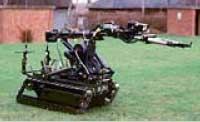Improvised Explosive Device Disposal
 Project purpose and history
Project purpose and history
The purpose of this project is to enhance the NZDF's existing Improvised Explosive Device Disposal (IEDD) capability and develop a credible chemical, biological, radiological, and conventional IEDD capability. Both capabilities cover detection, identification, field evaluation, rendering safe recovery, and final disposal.
In 1998, Cabinet directed the NZDF to provide the capability to render safe any explosive emergencies throughout New Zealand , including improvised explosive devices, by a specialised unit on a 24-hour basis, 365 days a year.
Cabinet directed that the NZDF should have IEDD teams located in Auckland , Wellington , and Christchurch . The desired response time was one hour for incidents within the central business districts, airports, and seaports of these cities. Cabinet also set a desired dispatch time of one hour for an IEDD team to depart to an incident anywhere else in New Zealand.*
In October 2004, Cabinet approved the inclusion of an IEDD that could deal with chemical, biological, or radiological threats in the 2004 LTDP, at a cost of about $25 million. Cabinet invited a report back from the Minister of Defence with options for an IEDD that could deal with chemical and biological threats, including more accurate costs and the source of funding, before seeking proposals from manufacturers and suppliers.
The subsequent report identified four options.** The estimated costs ranged between $16.6 million and $20.4 million,*** depending on the number of units required, their composition, and location.
On 7 March 2005, Cabinet approved the fourth option at an estimated cost of $19.7 million. Cabinet also requested a report by 30 June 2005 on the need for, and the practicality and indicative cost of establishing, a radiological capability, as well as the operating and capital implications of establishing the IEDD capability
That report requested approval for capital expenditure of $21.6 million, and operating funding up to $8.9 million each year. It noted that, since the last Cabinet approval, the figures for the total cost of establishing a national IEDD that could deal with chemical, biological, radiological, and conventional explosive threats had been confirmed. The report also noted that training would be needed as well as the purchase of the equipment. There was likely to be a delay in acquiring and introducing into service some of the equipment, because of international demand. Accordingly, the delivery of the complete capability was estimated to be as late as the 2007/08 financial year. Cabinet agreed to the capital expenditure and operating funding in July 2005.
The Ministry's Evaluation Division completed a report on this acquisition (entitled Introduction of Enhanced IEDD Capability, dated 10 September 2007). The report concluded that the required infrastructure would be largely in place by early 2008, but because infrastructure costs were exceeding the budget there was likely to be a need for the NZDF to seek additional funds from Cabinet to complete the project.
At the time of the evaluation report, the target date for introducing the full capability into service was July 2010. The report noted that that timing was at risk because there were not enough suitably trained and qualified personnel.
Cost and time frame changes for the Improvised Explosive Device Disposal project
Costs and time frames at the Approval to Commence and Approval to Commit points, and the NZDF's forecast as at April 2008
| Approval to Commence point | Approval to Commit point | Current NZDF forecast | |
|---|---|---|---|
| Cost (excluding GST) |
$19.7m | $21.6m | NZDF advised in April 2008 that the budget of $21.6 million was likely to be exceeded. The projected shortfall then was $0.75 million |
| Time frame | No indication of timing 1 | Delivery of the complete capability was estimated to be as late as the 2007/08 financial year 2 | July 2008 for the Directed Level of Operational Capability |
Sources
- Cabinet approval of 7 March 2005.
- Cabinet approval of 25 July 2005.
Changes to costs and time frames as the project has progressed
| Approval to Commence point to Approval to Commit point | Approval to Commit point to current NZDF forecast | Total change between the Approval to Commence point and the NZDF forecast | |
|---|---|---|---|
| Cost (excluding GST) |
+$1.9m 1 | +$0.8m 2 | +$2.7m |
| Time (months) | Not possible to calculate because there was no indication of timing in the Cabinet Approval to Commence | 0 | 0 |
Explanatory notes
- This is the difference between the figures in the March ($19.7 million) and July ($21.6 million) Cabinet approvals.
- We have rounded the current forecast shortfall ($0.75 million) up to one decimal place.
* See draft Cabinet paper circulated within the NZDF before it was sent to external agencies for comment, dated 10 January 2005.
** Submission to the Cabinet Policy Committee "National Im provised Explosive Device Disposal Capability", pp 4-5.
*** We note that the costs in that Cabinet submission include GST, while other approvals exclude GST. For consistency, we express the costs without GST.
page top